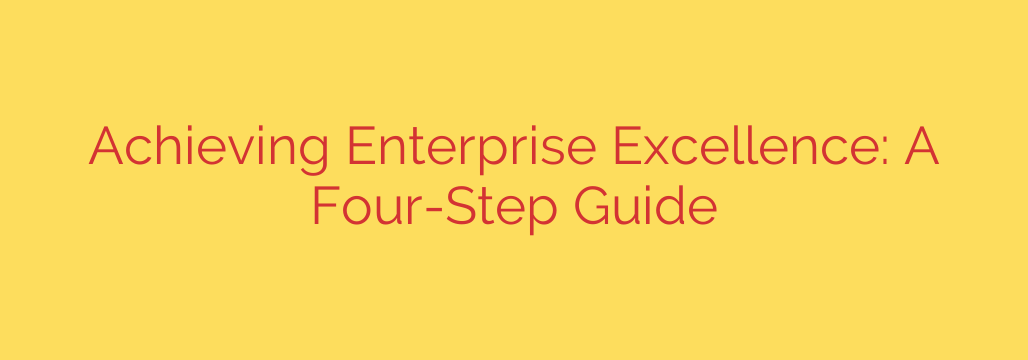
A Practical Guide to Enterprise Excellence: 4 Steps to Transform Your Business
In today’s competitive landscape, standing still is the same as falling behind. Businesses are constantly searching for ways to improve efficiency, drive innovation, and deliver exceptional value to their customers. The answer isn’t a single tool or a short-term fix, but a holistic commitment to Enterprise Excellence—a strategic approach that aligns your entire organization toward continuous improvement and sustainable success.
Enterprise Excellence is more than a buzzword; it’s a cultural shift that transforms how your business operates from the ground up. It integrates principles of process improvement, employee empowerment, and customer focus into the very DNA of your company. This guide breaks down the journey into four clear, actionable steps to help you build a more resilient, efficient, and market-leading organization.
Step 1: Lay the Foundation with Guiding Principles
Before you can improve, you must know what you stand for. The first step in achieving enterprise excellence is to define and codify the guiding principles that will act as your organization’s north star. These principles go beyond a generic mission statement; they are the fundamental beliefs that inform every decision, from the boardroom to the front lines.
These principles should be clear, concise, and focused on creating long-term value. They often revolve around core concepts like:
- Customer-Centricity: Placing the customer at the heart of every action.
- Respect for People: Valuing employees as your greatest asset.
- Continuous Improvement: Believing that every process can be made better.
- Process-Driven Thinking: Focusing on refining systems, not blaming individuals.
Actionable Tip: To begin, facilitate a leadership workshop to collaboratively define 5-7 core principles. Ensure these are not just words on a wall but are actively communicated and integrated into hiring, training, and performance reviews. Without a clear and shared set of principles, any improvement effort will lack direction and purpose.
Step 2: Align People, Processes, and Strategy
With your guiding principles established, the next challenge is to ensure they are reflected in your actions. This requires a deliberate effort to align your entire organization—your people, your processes, and your overarching strategy—with these core values.
Alignment means breaking down organizational silos and fostering a unified vision. Every team and individual should understand how their specific role contributes to the larger goals of the enterprise. Leadership plays a crucial role here, as they must consistently communicate the “why” behind the strategy and empower their teams to execute it.
This step involves:
- Cascading Goals: Translating high-level strategic objectives into meaningful targets for each department and team.
- Cross-Functional Collaboration: Creating systems that encourage departments like sales, operations, and finance to work together seamlessly.
- Visual Management: Using tools like strategy maps or dashboards to make progress and priorities visible to everyone.
Actionable Tip: True alignment happens when every employee can connect their daily tasks to the company’s ultimate goals. Conduct regular town halls or team meetings where leaders explicitly link ongoing projects to the guiding principles and strategic vision.
Step 3: Enable and Empower Your Teams to Drive Improvement
Enterprise excellence is not a top-down mandate; it is a bottom-up movement. The people closest to the work are often the ones who best understand the challenges and opportunities for improvement. Therefore, the third step is to provide your teams with the tools, training, and autonomy they need to make a real impact.
This is where methodologies like Lean, Six Sigma, and Agile come into play. However, the specific tool is less important than the underlying philosophy: empowering employees to identify problems, experiment with solutions, and implement changes. This creates a powerful sense of ownership and accountability.
Empowerment involves:
- Providing Training: Equipping employees with skills in problem-solving, data analysis, and process mapping.
- Fostering Psychological Safety: Creating an environment where people feel safe to point out flaws and suggest new ideas without fear of blame.
- Delegating Authority: Giving teams the power to make decisions about the processes they manage.
Actionable Tip: An empowered workforce is your greatest engine for innovation. Start by launching small-scale pilot projects where teams are given a specific problem to solve and the freedom to develop their own solutions. Celebrate their successes publicly to build momentum.
Step 4: Measure, Adapt, and Sustain the Momentum
The final step transforms enterprise excellence from a one-time project into a self-sustaining cycle. This is achieved through rigorous measurement, honest reflection, and a commitment to adaptation. What gets measured gets managed, and the right metrics are essential for tracking progress and ensuring your efforts are yielding results.
Focus on a balanced set of Key Performance Indicators (KPIs) that measure not only financial outcomes but also process efficiency, customer satisfaction, and employee engagement. Use this data not to punish, but to learn. This creates a continuous feedback loop—often referred to as the Plan-Do-Check-Act (PDCA) cycle—that drives ongoing refinement.
Sustaining the culture requires:
- Data-Driven Reviews: Holding regular meetings to review KPIs and discuss process health.
- Standardizing Success: When improvements are validated, make them the new standard operating procedure.
- Recognizing and Rewarding Behaviors: Acknowledge individuals and teams who exemplify the guiding principles and a continuous improvement mindset.
Actionable Tip: Enterprise excellence is a journey, not a destination; it thrives on a cycle of continuous learning and adaptation. Implement a simple, visible system for tracking improvement ideas from suggestion to implementation, ensuring that every contribution is acknowledged.
Building a Lasting Culture of Excellence
By systematically moving through these four steps—defining principles, aligning the organization, empowering teams, and creating a cycle of measurement—you can move beyond temporary fixes and build a true culture of enterprise excellence. This transformation creates a resilient organization that not only weathers market changes but leads them, driven by a shared commitment to delivering exceptional value every single day.
Source: https://cloud.google.com/blog/topics/partners/beyond-data-what-it-takes-to-win-with-ai/








